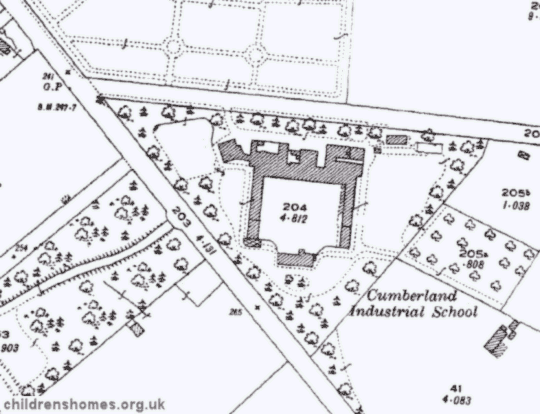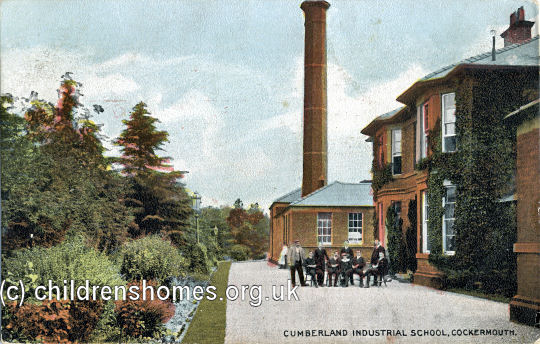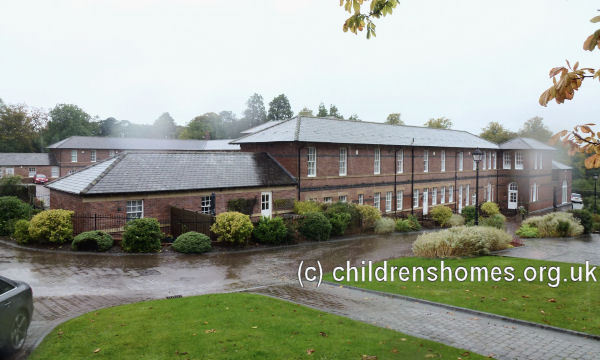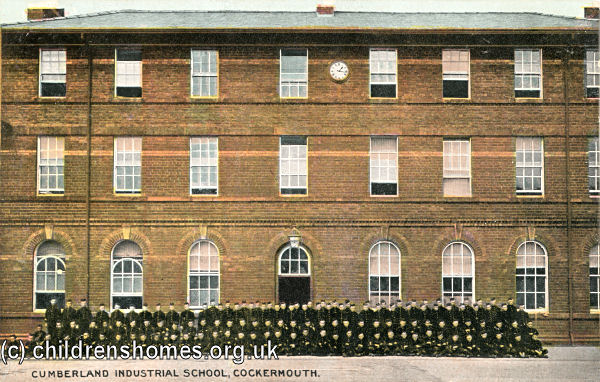Cumberland County Industrial School for Boys, Cockermouth, Cumberland
The Cumberland County Industrial School for Boys was established in 1881. The School occupied purpose-built premises on Strawberry How (or Howe) Road, Cockermouth, designed by the County Architect, Mr J.T. Cory, The new buildings were formally opened on 29th October, 1881, by the Home Secretary, Sir William Vernon Harcourt. On August 22nd, 1881, the establishment was certified to accommodate up to 150 boys, aged 6 to 13 years at their date of admission.
The School site is shown on the 1925 map below.

Cumberland County Industrial School for Boys site, Cockermouth, c.1925.

Cumberland Industrial School entrance from the north-west, Cockermouth, c.1905. © Peter Higginbotham

Former Cumberland Industrial School from the north-east, Cockermouth, 2013. © Peter Higginbotham

Former Cumberland Industrial School from the north, Cockermouth, 2013. © Peter Higginbotham

Former Cumberland Industrial School from the south-east, Cockermouth, 2013. © Peter Higginbotham

Former Cumberland Industrial School from the south, Cockermouth, 2013. © Peter Higginbotham

Former Cumberland Industrial School from the south, Cockermouth, 2013. © Peter Higginbotham
The first official inspection of the institution in 1882 noted that tailoring and shoemaking workshops had been established, and a sewing class set up for making and repairing shirts and socks. The boys assisted in the laundry and cooking, and also helped with the house cleaning. A band had been formed and the boys were being regularly drilled. The superintendent and matron the School were Mr and Mrs Alfred Arthur Williams, formerly in charge of the Stockport Boys' Industrial School.. The other staff comprised the schoolmaster, Mr C Brodie; a general assistant, Mr J Moore; tailor, shoemaker, gardener, baker, engineer, sewing mistress, laundress, maid servant, and band master.
by the 1890s, about 12 of the School's 30 acres were being cultivated as market gardens and for growing vegetables and grain for the School. The only livestock kept were a pony and a few pigs. Plans were made to develop the agricultural operation and erect farm buildings, although only one block, containing a stable, vegetable store and hayloft, was ever constructed. The School now had its own manual fire engine and a fire brigade was formed.
Mr and Mrs Williams remained in post until 14th July, 1902, when they were succeeded as superintendent and matron by Mr Charles Thornton Howes and Mrs Howes.
In 1903, a new schoolroom block was erected at the south of the main building. Part of the old schoolroom, in the main building, was then converted into a sitting room for the teaching staff, and the remainder into a recreation and reading room for the boys. At around the same date, the School's cells were converted into a dining-room for the officers, and 'telephonic communication' established between the hospital and the superintendent's bedroom. An open air swimming bath was constructed in 1908.

Former Cumberland Industrial School new school block, Cockermouth, 2013. © Peter Higginbotham
Following a steady decline in the number being admitted, the School closed in 1921. The was subsequently home to Cockermouth Secondary School (later County Grammar School) then in 1990 was taken over for use as offices and workshops. In 2004 the buildings were converted to residential use.
Records
Note: many repositories impose a closure period of up to 100 years for records identifying individuals. Before travelling a long distance, always check that the records you want to consult will be available.
- Whitehaven Archive and Local Studies Centre, Scotch Street, Whitehaven, Cumbria CA28 7NL. Holdings include: Annual Reports (1884-87), rules and regulations, dietary table, timetable, various plans etc. but no inmate records.
Bibliography
- Higginbotham, Peter Children's Homes: A History of Institutional Care for Britain's Young (2017, Pen & Sword)
- Mahood, Linda Policing Gender, Class and Family: Britain, 1850-1940 (1995, Univeristy of Alberta Press)
- Prahms, Wendy Newcastle Ragged and Industrial School (2006, The History Press)
Links
- None noted at present.
Except where indicated, this page () © Peter Higginbotham. Contents may not be reproduced without permission.


